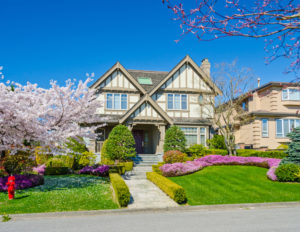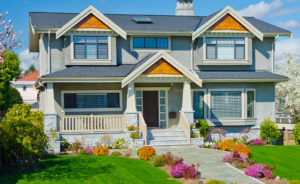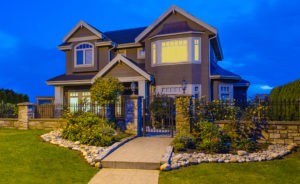While architects have often noted that landscape architecture has lagged the modernist building movement since the late 1930s, these days, there’s consensus that your garden should, if not match, at least coordinate with your home.
An English country garden may work just as well with a Cape Cod style home as it does with a thatched Tudor cottage. However, it really doesn’t suit a Frank Lloyd Wright-inspired angular home with clean lines and lots of glass.
Try to match your garden’s style to your home when it comes to size, color, and style for a clean, comforting appearance.

Size
If you’ve got a tiny little porch, don’t flank your home’s entryway with massive flower pot sentinels. That will only emphasize how small your porch is. Similarly, if your front yard is the size of a pocket handkerchief, perhaps bursts of color from small petaled trailing plants like lobelia are a better idea than a hibiscus bush. Save the big, showy flowers for those you can train to grow on a trellis against the house, like a clematis.
If, on the other hand, you’ve got a huge front yard, you may want to create interest by designing winding pathways that delineate different kinds of gardens: flower from herb, annual from perennial, rose garden from mixed flowers, Zen garden from rock garden. Also, you’ll want to scale up the size of your plants as well. If you’re working with a big space, you can invest in plants like hostas and hydrangeas, which will grow and grow and grow until you cut them back.
Try to scale the size of your plantings to the size of your home. If tiny and perfect works for your house, it’ll work for your garden too. Make sure, if you have a small home on a small lot, that you keep both evergreen and deciduous trees trimmed. Letting them get too tall isn’t just an aesthetic faux pas, it can be dangerous, given the severity of many storm events.

Color
Repeating your home’s paint colors in your garden’s foliage or flowers is one way to link interior and exterior. Think of the house color as the flower painting’s backdrop. You can echo your home’s color scheme, or you can choose contrasting colors to make your garden pop.
The easiest house colors to integrate with foliage are, of course, greens and browns. But you can use your garden flowers to both amplify and contrast with your home’s exterior wall color.
White has a commanding presence in a garden, and some landscape gardeners think it should be used with care, to create a focal point or unite a space. Trim and roof colors should be repeated throughout a garden, with white or off-white plantings as accents or unifying elements with any house that has white or cream in its paint scheme.

Style
The warm texture of a red brick house with gingerbread trim and deep overhangs calls for one kind of garden and a specific range of plants, while the neutral concrete and glass angles of a modern, custom-built home would look silly adorned with petunias.
If you’ve bought a heritage home, honor its stature with traditional and vintage garden designs. Make use of arbors and hanging baskets on the porch. Flank a colonial style home’s front door with large planters bursting with trailing flowers. Create a rose or hydrangea or French herb garden. Build a latticework gazebo.
Landscape architects suggest using foliage as building blocks with modern design, and some of the best examples of this are of rectangular planters filled with wild and spikey decorative grasses. The abundance, movement, and deep true colors of the grasses provide contrast to the neutral color scheme. They also supply texture, movement, and a wildness that works well with a very precise and sometimes coldly confrontational architectural style.
Modern architecture lends itself very well to xeriscaping, and once a xeriscape lawn has been designed and planted, it matches the spirit of modern architecture: clean lines, low maintenance, and a lack of ornamentation. Vertical gardens and green walls work very well with modern architecture too, providing a shot of color and free form design, adding a bit of warmth and interest to hard edges. Planning, planting, nurturing, and appreciating your garden should be a voyage of exploration and discovery, something you perfect over the course of years. Don’t be afraid to try new colors, plants, and accessories to see what works and what doesn’t. Most importantly, don’t forget that gardening can be a year-long passion. After all, the important work gets done in winter: planning, poring over seed catalogues, and researching patio stones, water treatments, wind chimes, and lawn furniture.


